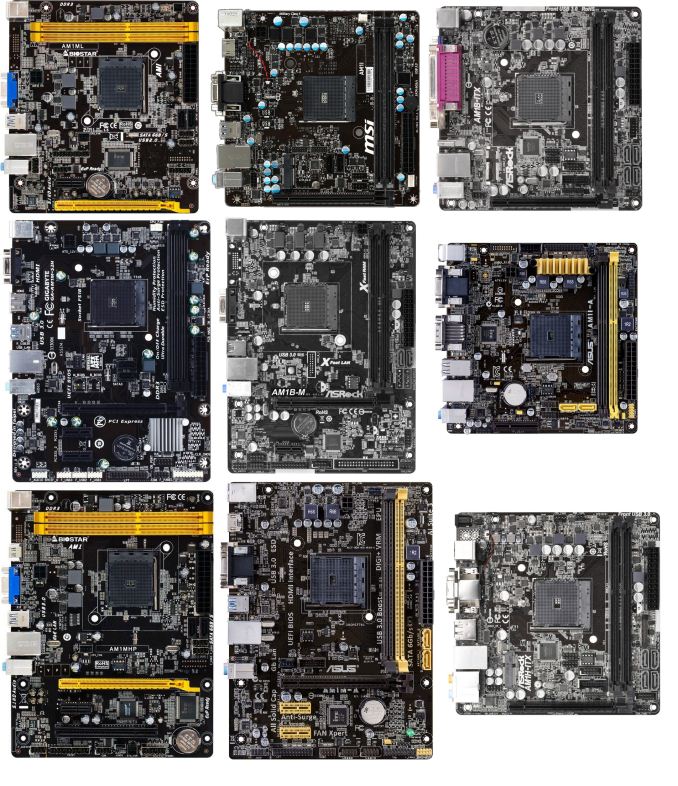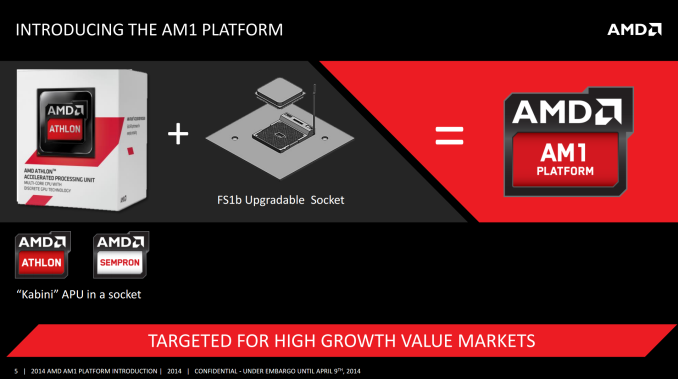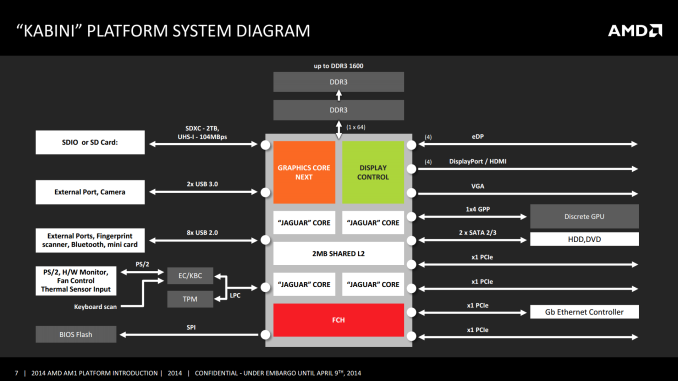The AM1 Kabini Motherboard Preview: Analyzing the Hardware
by Ian Cutress on April 19, 2014 2:00 PM EST
One of AMD’s primary feature points for the AM1 Kabini platform was the introduction of low-cost motherboards. The promotional material provided gave a suggested AM1 combined price of $60. Now after release the cheapest APUs are $31 for a dual core and $35 for a quad core. This should mean motherboards from $29 and up. Today we take a brief preview of nine motherboards currently on sale, which start at $33.
The AM1 Ecosystem
Almost every end-user I converse with prefers naming consistency in technology products. There has to be a clear progression in naming structure showing the development of a platform over time and generations. There have been plenty of examples – AMD’s enthusiast chipset (580/690/790/890/990FX), both AMD and NVIDIA’s GPU lines, Intel’s chipsets (P35, X48, P55, P67, Z77, Z87). The issue arises when the naming scheme is non-contiguous. The naming of AMD’s three main processor and chipset lines are as follows:
The top end features the AM3+ socket, which came from AM3, AM2+ and AM2. The mid-range is the FM2+ socket, deriving from FM2 and FM1. The low-price segment is now being called the ‘AM1 platform’. It makes it sound like it should be a very old version of AM3, because at least colloquially it will just be called AM1. In reality, that word ‘platform’ is the kicker here, because the socket is actually called FS1b:
What makes it called the AM1 platform is the use of a Kabini APU in an FS1b upgradable socket. That does not help that all the motherboards on sale will be given the AM1 designation. This means that if the next iteration of the Athlon processors using ‘Puma’ cores (codename “Beema”) comes along and they call it the ‘AM2 platform’ (insert more confusion with the AM2 socket), it might still be the FS1b socket in the middle of the motherboard.
Naming conventions aside, because Kabini processors are system-on-chips rather than platforms with a discrete south bridge, all the IO is determined on die. AMD is at least keeping the core of the IO the same across all the Kabini APUs:
The key points to note here are:
- Single Channel 64-bit DDR3/DDR3L
- Two USB 3.0
- Eight USB 2.0
- PS/2
- Trusted Platform Module Support
- Up to four eDP/DP/HDMI video outputs
- VGA output
- Four PCIe 2.0 lanes for a discrete GPU/PCIe device
- Two SATA 3 Gbps ports
- One PCIe 2.0 x1 lane allocated to an Ethernet controller
- Three PCIe 2.0 x1 lanes for other controllers (SATA, USB, LAN, WiFi, PCIe 2.0 x1 slots, PCIe to PCI bridges)
As we go through the following motherboards, we will see that some manufacturers use USB 3.0 or SATA 6 Gbps controllers, powered by the PCIe 2.0 x1 lanes, in order to bump up the functionality. There is scope for development in the networking and audio solutions as well.













64 Comments
View All Comments
RoboJ1M - Tuesday, April 22, 2014 - link
I've been wondering how these AM1 boards can be so cheap compared to the usual ITX fare.It occurred to me that if Kabini is a SoC, does that make these mobos basically breakout boards? Like you get for Computers on Module stuff?
Ortanon - Tuesday, April 22, 2014 - link
That's more or less accurate, yeah. Which means the boards should be cheaper than they currently are; it's just that it's brand new. So later this year we should see a lot of price drops.Haravikk - Sunday, April 27, 2014 - link
Personally I prefer the "horizontal" RAM layout, and I'm surprised more manufacturers don't use it, as it's just better for cooling overall IMO. The only issue really is that many coolers aren't designed for it, because not enough motherboards do it, but if they did then cooler manufacturers would adapt. We can only hope.Personally I don't see the point of the PS/2 port(s) on these motherboards, likewise with VGA. I think that nowadays that HDMI and USB are so common that you're not saving much (if any) money opting for older standards unless you just happen to have these lying around. Even so, I have two HDMI to VGA adapters just lying around, so it's not like it'd be hard to hook up a VGA monitor anyway if you really needed to.
medra - Saturday, June 14, 2014 - link
"The AM1H-ITX is also the only motherboard in this roundup with a 7.1 audio codec, using the Realtek ALC892 compared to the ALC887 or ALC662 on the others which are both 2.1 at best."Actually, ALC887 is a 7.1 channel HD Audio Codec while the ALC662 is a 5.1 channel HD Audio Codec.